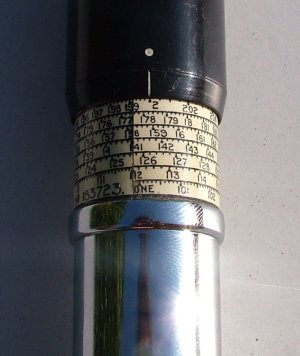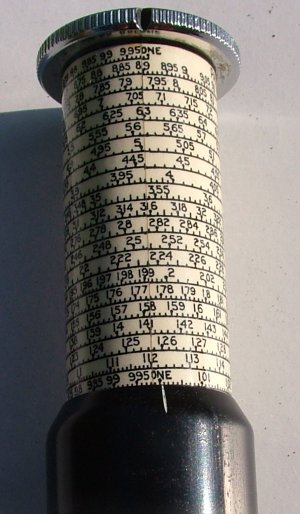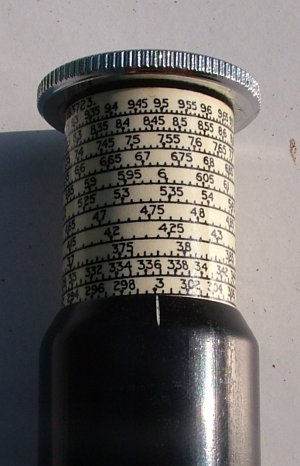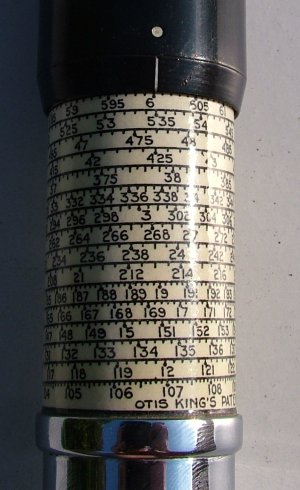Home
+
About me
+
E-mail me
Otis King model K Calculator

Extended and ready for action. From the left: the chrome handle (the fixed
part); the lower scale (fixed to the handle); the black cursor which slides
along and around the fixed part, with two pointers L (left) on the lower
scale and T (right) on the upper scales; the upper scales, which slide in
and out of the fixed part and can be rotated, they are operated by the
knurled knob at the right. In use the handle is usually held by the left
hand and the calculator held roughly horizontal and pointing away, looking
down onto the scales.

Closed
Multiplication
This is the basic procedure for multiplication, for example 2 times 3.
First open the calculator up, if it isn't already, then move the cursor to
set its lower pointer L over 2 on the fixed scale at the bottom near the
handle:

Then move the top scales to bring the ONE at the centre of the two scales
over the upper pointer T on the cursor:

Then move the cursor again to bring the upper pointer T over 3 on one of
the upper scales. The right scale is the one that will bring the lower pointer
L of the cursor over the lower scale. In this case we move the cursor upwards
from the centre ONE:

The result, 6, is then read on the lower scale, under the lower pointer
L:

This can carry on indefinitely as the result is in the correct place to
start another multiplication. On the model K (like this one), which has two
conventional
logarithmic scales at the top, it is always possible for the second move to
set the centre ONE under T. On the model L, which has only one normal upper
scale, it is necessary at times to use the ONE at the top instead. The model
L has a scale for reading logarithms as the lower of the two upper scales;
this makes it more powerful but less easy to use for simple calculations.
Division
Division can be shown from the same images in a different order. To divide
6 by 3 first set 6 under the lower cursor L:

Then move the upper scale to bring 3 under the pointer T:

Then move the cursor pointer T to the ONE index in the centre of the two
upper scales:

And finally read the answer 2 under the lower pointer L:

Again the result is under L on the lower scale, so multiplication and
division can be chained in any order.
In some cases in may be necessary to use a different ONE on the
upper scale to get in range with the lower scale.
(You can see from the last image that the scales are printed on paper then
wrapped around the cylinder; the oblique evening sun under which this photo was
taken has pulled a shadow from the slightly raised edge where the glue is
failing.)
How it works
Operation is very similar to a conventional slide rule, which is
described here.
The diagrams show how the cursor is used to add distances from the two
separated scales. To make this clear, the scales are shown as
simple linear scales rather than spirals. The left-hand scale is the lower,
fixed scale near the handle, the right-hand scale the upper,
moveable scale and the
block at the bottom is the cursor with its two marks. The cursor is shown
rather longer than the real one, as my scales don't fit one down inside
the other like on the real instrument.

The first move is to put the cursor pointer B over 2 on the lower scale.
Cursor B is then at a distance representing log(2) from the index mark of
this scale.

Then the upper scale is moved to bring an index mark under the
upper cursor mark T.

The cursor is then moved to bring cursor mark T over the 3 on the
upper scale. This moves the cursor by a distance representing log(3).
As the pointers are at a fixed separation, the lower cursor marker B
also moves by log(3), and as it started at log(2) it now represents
log(2) + log(3) which is log(6). So the result is found under B.

The critical distance for accuracy is the distance along the spiral
scale. This is stored as rotation of the cursor or scale, with the axial
movements counting the number of complete turns. So when placing the cursor
marks the angular position must be precise if accuracy is not to be lost,
but axial position error is insignificant unless it is so large that the
result is read from the wrong turn, an error of twentieth-root of ten.
The instrument would (in theory) work just as well if each cursor point
had a peg
that fitted into a groove that ran along the spiral track. Then it would
be more clear that these are folded 1-dimensional movements rather than
the apparent two-dimensional movements; of course it were like this it
would be tedious to use as you'd have to turn the cursor and end scale
dozens of times in the course of a calculation.
My slide rules
+
How to use a slide rule
+
Note on accuracy
Home
+
About me
+
E-mail me
 2008-04-17 .. 2008-05-25
(+44 7010 700642)
2008-04-17 .. 2008-05-25
(+44 7010 700642)










 2008-04-17 .. 2008-05-25
(+44 7010 700642)
2008-04-17 .. 2008-05-25
(+44 7010 700642)